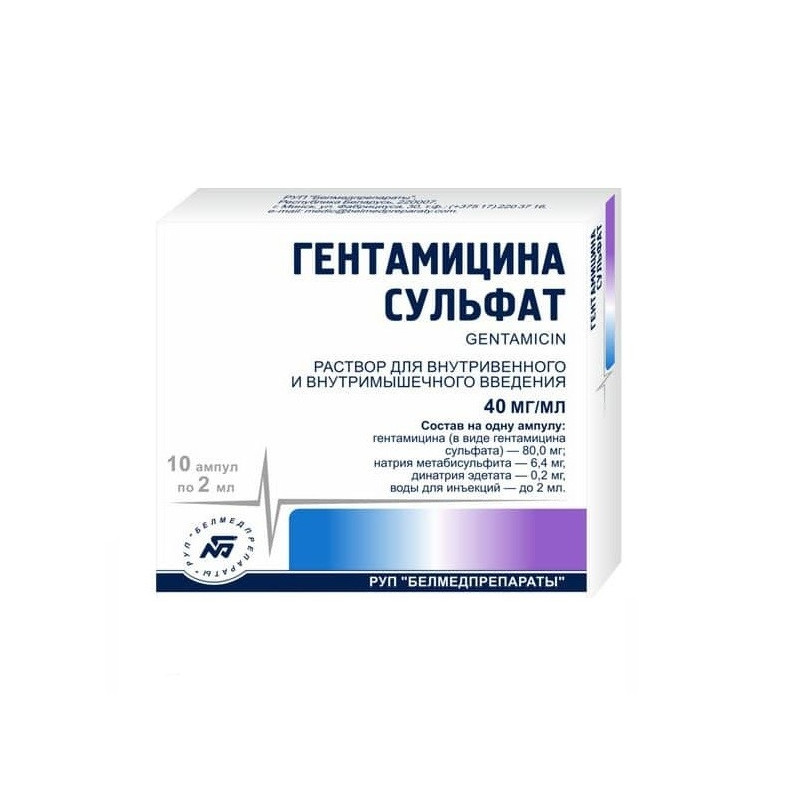



 All payments are encrypted via SSL
All payments are encrypted via SSL
 Full Refund if you haven't received your order
Full Refund if you haven't received your order
10 pieces
HENTAMYCIN is an antibiotic of a broad-spectrum aminoglycoside group. It has a bactericidal effect. Actively penetrating the cell membrane of bacteria, irreversibly binds to the 30S subunit of bacterial ribosomes and, thus, inhibits protein synthesis of the pathogen.
Highly active against aerobic gram-negative bacteria: Escherichia coli, Shigella spp., Salmonella spp., Enterobacter spp., Klebsiella spp., Serratia spp., Proteus spp., Pseudomonas aeruginosa, Acinetobacter spp.
Also active with aerobic gram-positive cocci: Staphylococcus spp. (including resistant to penicillins and other antibiotics), some strains of Streptococcus spp.
Neisseria meningitidis, Treponema pallidum, some strains of Streptococcus spp., Anaerobic bacteria, are resistant to Gentamicin.
Infectious and inflammatory diseases caused by microorganisms susceptible to gentamicin.
For parenteral use: acute cholecystitis, cholangitis, pyelonephritis, cystitis, pneumonia, empyema, peritonitis, sepsis, ventriculitis, purulent infections of the skin and soft tissues, wound infection, burn infection, infections of bones and joints.
For external use: pyoderma (including gangrenous), superficial folliculitis, furunculosis, sycosis, paronychia, infected seborrheic dermatitis infected with acne,secondary bacterial infection in case of fungal and viral infections of the skin, infected skin wounds of various etiologies (burns, wounds, difficult healing ulcers, insect bites), infected varicose ulcers.
For local use: blepharitis, blepharoconjunctivitis, dacryocystitis, conjunctivitis, keratitis, keratoconjunctivitis, meybomit.
Hypersensitivity to gentamicin and other aminoglycoside antibiotics, acoustic neuritis, severe renal dysfunction, uremia, pregnancy, lactation (breastfeeding).
Gentamicin contraindicated in pregnancy. If necessary, use during lactation should stop breastfeeding.
Set individually, taking into account the severity of the course and localization of infection, the sensitivity of the pathogen.
When in / in or in / m administration for adults, a single dose is 1-1.7 mg / kg, daily dose - 3-5 mg / kg; the frequency of administration is 2-4 times / day. The course of treatment is 7-10 days. Depending on the etiology of the disease, it is possible to use at a dose of 120-160 mg 1 time / day. within 7-10 days or 240-280 mg once. In / in the infusion carried out within 1-2 hours
For children older than 2 years, the daily dose of gentamicin is 3-5 mg / kg; the frequency of administration is 3 times / day. Premature and newborn babies are prescribed in a daily dose of 2-5 mg / kg; the frequency of administration is 2 times a day; children up to 2 years old are prescribed the same dose at a frequency of 3 times / day.
Patients with impaired renal excretory function require correction of the dosing regimen, depending on the values of QC.
When applied topically gentamicin 1-2 drops are instilled into the lower conjunctival sac of the affected eye every 1-4 hours.
When applied topically, use 3-4 times / day.
Maximum daily doses: for adults and children with a / in or / in the introduction - 5 mg / kg.
Gastrointestinal: nausea, vomiting, increased activity of hepatic transaminases, hyperbilirubinemia.
Hemic and lymphatic: anemia, leukopenia, granulocytopenia, thrombocytopenia.
Urogenital: oliguria, proteinuria, microhematuria, renal failure.
Nervous system: headache, drowsiness, impaired neuromuscular conduction, hearing loss, vestibular disorders, irreversible deafness.
Allergic reactions: skin rash, itching, urticaria, fever, rarely - angioedema.
With simultaneous use with aminoglycosides, Vancomycin, cephalosporins, ethacrynic acid may increase oto-and nephrotoxic action.
With simultaneous use with Indomethacin, there is a decrease in the clearance of gentamicin, an increase in its concentration in the blood plasma, and the risk of toxic action increases.
With simultaneous use with agents for inhalation anesthesia, opioid analgesics increases the risk of neuromuscular blockade, up to the development of apnea.
With the simultaneous use of gentamicin and "loop" diuretics (furosemide, ethacrynic acid), the concentration of gentamicin in the blood increases, and therefore the risk of toxic side reactions increases.
Gentamicin